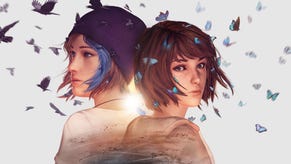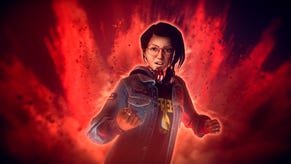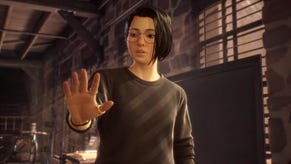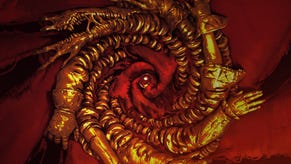Life is Strange's "Triforce" of Influences
Creative director Jean Maxime discusses the development of Life is Strange's time mechanic, the decision to set the story in Oregon, and more.
This article first appeared on USgamer, a partner publication of VG247. Some content, such as this article, has been migrated to VG247 for posterity after USgamer's closure - but it has not been edited or further vetted by the VG247 team.
The latest in what has become a robust genre of episode adventure games arrived on digital distribution yesterday. Life is Strange tells the story of Maxine "Max" Caulfield, a photography student who suddenly discovers that she has the power to rewind time and change her decisions.
Drawing heavily on the look and feel of independent films set in the Pacific Northwest, it is meant to be a coming of age story, but with a supernatural element. In my time with it, I was struck by the contemplative soundtrack (lots of folk music), its use of autumn colors, and of course, the time travel mechanic itself. The first episode is a promising first step into what is hopefully a very interesting story running through the rest of the year.

In the course of playing Life is Strange, I had a chance to speak with creative director Jean Maxime, who shared his thoughts on the story's themes, the time rewind mechanic, and its "triforce" of influences.
USgamer: What prompted you to move into episodic gaming?
Jean Maxime, Creative Director: It was a creative decision. We wanted to make something that was exotic, but we also needed to do something smaller because we're in trouble right now. It's one of those things where you can't say that you're only going to do AAA becaue those $20 or $30 million budgets don't come along every day. The decision to do something smaller was induced by the conditions and the environments, but to go exotic was really us being big fans of what Telltale has been defining in terms of where the adventure game was going to go for the next few years.
USG: So you picked the Pacific Northwest, which seems to be a fairly common setting recent, and you referred to it as "nostalgic." What about it is nostalgic to you?
JM: If this game was a season, we'd say that it's autumn. It has a sense of nostalgia over the summer days gone, but it still has this inner warmth that you carry with you that shines everyday even as the length of the days start to decline. To me, if Oregon were a season, it would be autumn, too. I don't know how much sense that makes, but our conception team had all been to Oregon before, and it just came out very naturally when we were thinking about the game. I'm not sure if it's the fact that there's trees everywhere, the presence of the sea... To me, it's a more poetic version of California. But it came out pretty easily. Yes, it is a rather common setting in independent movies, but so is Paris.
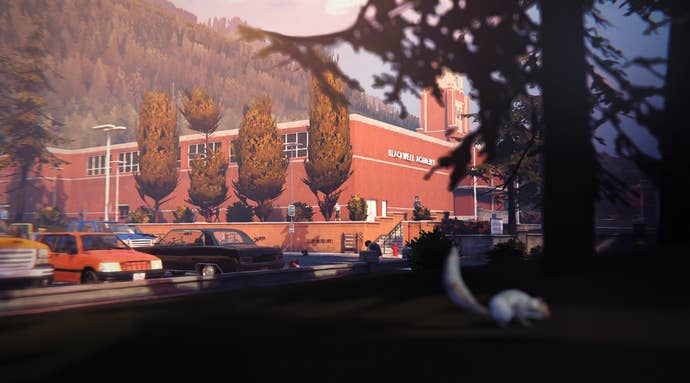
USG: The main character strikes me as kind of withdrawn, focused on her art... like a wounded bird, say. Is that fair to say?
JM: It is. She is much more at ease behind the camera than in front of it. And the other character, Chloe, is really the yang to her ying, but that will evolve throughout the game. You know, Chloe might look like she knows who she is much more, but she's actually up a lot, and she doesn't really know who she is yet. That's the quest they embark on together. And even though in the beginning it might seem like Chloe has the upper hand on Max, that's going to change several times throughout the game.
USG: There was a moment that confused me. She's in the bathroom and you see Nathan pointing a gun at Chloe, and it seems like Max doesn't know who Chloe is despite being friends with her. Could you explain that moment?
JM: We actually leave it open to interpretation. It might be that she doesn't recognize her because they've grown a lot in five years and she has blue hair and a beanie. Or she did and didn't know what to do. Or she recognized her and was overwhelmed by the situation. You actually get the choice in Chloe's room to say whether you recognize her or not.
USG: And the guy with the gun... Nathan Prescott... strikes me as a bit of a psychopath.
JM: Yeah, his family has a lot of money, and he is not an easy person to be around. That's definitely not the only crazy thing he's going to do.

USG: I would define the pace as languid in that you set up the time travel thing and the main character is clearly freaked out, and she sees this really scary moment of Nathan with the gun. But then things slow down a lot and she's trying to get her flash drive to Warren, and things like that. I feel like meandering is a word that has a negative connotation, but it takes its time moving along. Why did you take that approach with the pacing?
JM: It definitely is a more contemplative game than Remember Me, for instance. I always say that there's a triforce of influences on Life is Strange, and they are Gone Home, the Walking Dead, and Heavy Rain. One thing we loved about Gone Home, and by the way we already had these intentions for Life is Strange and it was already set in the Pacific Northwest before Gone Home came out, was that we wanted you to be able to tell yourself as much of a story as you want. So there is the main story you have to go through, there are all the secondary characters you don't have to interact with, and then there's all the very small interactions and pictures you can look to take. The intention is that it's an essentialist approach. We want you to become Max rather than seeing her do things, and that comes with a level of freedom regarding how much you want to explore your surroundings. I guess we were also a bit traumatized by the backlash we received from Remember Me, and we wanted to do something more open. So it does have this much slower paced dynamic to it.
USG: The notion of being able to rewind time is a very heady concept. It reminds me of a cartoon from a long time ago where one of the main characters gets a similar ability, and he keeps rewinding time until everything falls apart. So with your own game, what kind of questions and themes do you want to evoke with this ability.
JM: So first of all, it is a very difficult notion to tackle. It sounds very cool on paper, but it's extremely difficult to bring to life because of the time paradoxes and so many other things. That's why we had the rules of keeping your position, keeping your items, keeping your knowledge, so that there are cracks in the realism of time rewinding which actually isn't that realistic at all, which we can play around with a bit. Now what we're trying to evoke is that it's a coming of age story; it's about becoming an adult, and to us, becoming an adult is making choices and standing by those choices. But in the beginning, we give you the ability to not stand by those choices, and that's the mechanic we're going to question more and more through the game in many different ways. We are evoking the fact that while you can have what you want in terms of choices, there will be consequences.
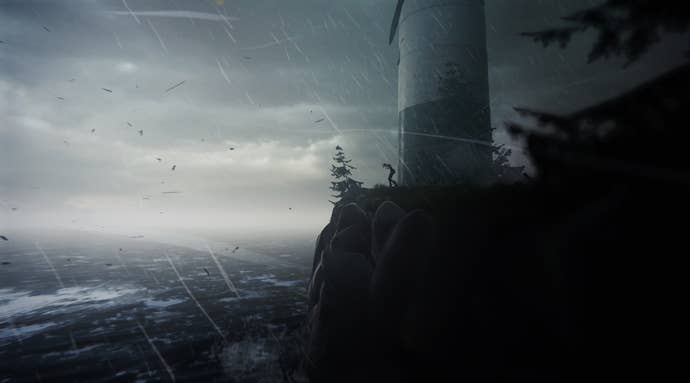
USG: Can you give me an idea of how complicated it's going to become? Thus far, it's been pretty binary.
JM: One of the uses obviously is to rewind your choices, but then we also use it in puzzle situations. That is, for example, to predict the future; like, you live an hour of your life, and then you know everything that is going to happen. We use it to re-orient dialogue. For instance, I can rewind time and use that dialogue against someone. And those different things are going to be combined in more and more complex ways, but we also want to keep it simple. It's a simple dialogue that hopefully you will find goes deeper throughout the series. The extent of the repercussions are also something we want to play with; and without spoiling too much, if you've ever seen the movie The Butterfly Effect, then you know what I mean.
USG: I know that in the end of The Butterfly Effect the main character is never born.
JM: That's in the director's cut. And I love the director's cut because at the end of the regular movie, they get married. Whereas the idea of the main character never being born... that was so... I don't know. I remember watching it when I was in China alone and thinking, "My god, this guy just went back to his mother's womb to commit suicide. Um, okay." [laughs]
USG: You were talking about The Walking Dead. As you know, it's a well-regarded franchise, but one of the criticisms of it is that its puzzles are generally pretty simple. Are you making an effort to emphasize puzzle solving more?
JM: Slightly more than The Walking Dead, although I think the modern adventure game focuses much more on storytelling and player consequence than puzzles, whereas older adventure games could be just about solving puzzles and clicking around a million different things before finding the right combination. But we have an additional mechanic compared to The Walking Dead and we are using it in puzzle sequences, so it's slightly more than The Walking Dead.
USG: Thinking about the challenges of making a game like this where choices are so important. How hard is it to keep this butterfly effect from spinning completely out of control?
JM: The idea is that we keep it under control by making sure it doesn't spin off in a hundred different directions. There's no path that opens up in Paris, for instance, with another one in San Francisco and another in New York. The same main events will happen but for different reasons depending on how you play. And to me, what's important is to make sure that your experience feels different from someone else's. It's your choices that determines how the story is told; simple things like a different line of dialogue, a different shot in a sequence, a different look from a character, different message on the radio, different animation, different text message.... There's about 20 things that we've flagged in Episode 1, and as you progress through each episode there's more and more and more, then we can combine all of these options. Even if it's just a text message that you get, you can be like, "Okay, that's really interesting, because I played it that way." What you get, even though it's just a few lines of text, is different from 99 percent of the other players. So it feels unique.
USG: One of the throughlines from Remember Me to Life is Strange is memory and reflection. What is it about those particular themes that interest you?
JM: You know, I don't know. I agree with you, but we only realize it when we post-rationalize it. We don't go in and say, "This is what we want to do." The theme just sort of emerges. What it says about me and my studio, I hope I find out someday. When we went into this thing we knew that we wanted to do time rewind, and we knew that we wanted to go episodic. And we wanted to do the time rewind because we hadn't done enough, we thought, with Remember Me, and because we had the tech. But why did we do it in the first place? Why was it that feature that we wanted to keep rather than doing a combo-based game and improving on what we had? I don't know yet, but you're right.
USG: Finally, the adventure genre is pretty crowded these days. What kind of mark do you want to make on it? How do you want to stand out?
JM: We want to be the ones that do something at the crossroads at the influences I mentioned, but that tackle realistic and universal themes, but in a very poetic way. I like that the supernatural elements in the game are more an echo of what's going on in the characters than just cool things that we have. I like the treatment of it, and I think it stands out. I think other people are doing it, but it's very difficult to be absolutely unique. That's what I think I would like people to say of us.





